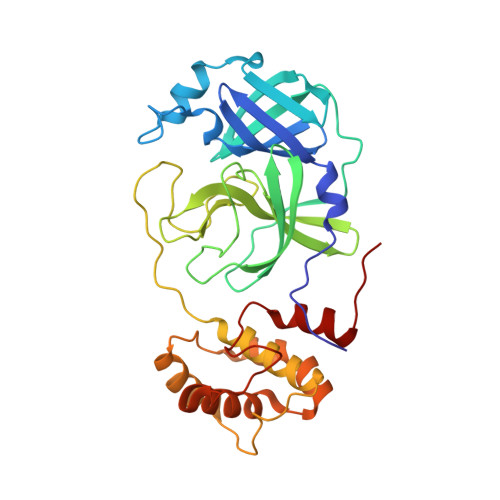Structural, Electronic, and Electrostatic Determinants for Inhibitor Binding to Subsites S1 and S2 in SARS-CoV-2 Main Protease.
Kneller, D.W., Li, H., Galanie, S., Phillips, G., Labbe, A., Weiss, K.L., Zhang, Q., Arnould, M.A., Clyde, A., Ma, H., Ramanathan, A., Jonsson, C.B., Head, M.S., Coates, L., Louis, J.M., Bonnesen, P.V., Kovalevsky, A.(2021) J Med Chem 64: 17366-17383
- PubMed: 34705466
- DOI: https://doi.org/10.1021/acs.jmedchem.1c01475
- Primary Citation of Related Structures:
7N8C, 7RLS, 7RM2, 7RMB, 7RME, 7RMT, 7RMZ, 7RN4, 7RNH, 7RNK - PubMed Abstract:
Creating small-molecule antivirals specific for severe acute respiratory syndrome coronavirus 2 (SARS-CoV-2) proteins is crucial to battle coronavirus disease 2019 (COVID-19). SARS-CoV-2 main protease (M pro ) is an established drug target for the design of protease inhibitors. We performed a structure-activity relationship (SAR) study of noncovalent compounds that bind in the enzyme's substrate-binding subsites S1 and S2, revealing structural, electronic, and electrostatic determinants of these sites. The study was guided by the X-ray/neutron structure of M pro complexed with Mcule-5948770040 (compound 1 ), in which protonation states were directly visualized. Virtual reality-assisted structure analysis and small-molecule building were employed to generate analogues of 1 . In vitro enzyme inhibition assays and room-temperature X-ray structures demonstrated the effect of chemical modifications on M pro inhibition, showing that (1) maintaining correct geometry of an inhibitor's P1 group is essential to preserve the hydrogen bond with the protonated His163; (2) a positively charged linker is preferred; and (3) subsite S2 prefers nonbulky modestly electronegative groups.
Organizational Affiliation:
Neutron Scattering Division, Oak Ridge National Laboratory, Oak Ridge, Tennessee 37831, United States.















